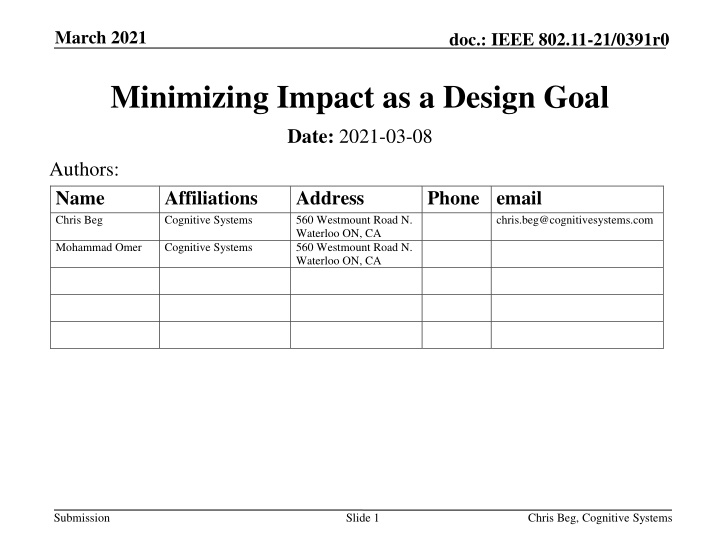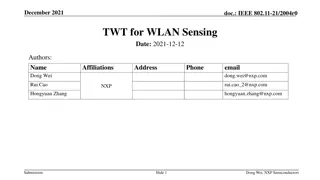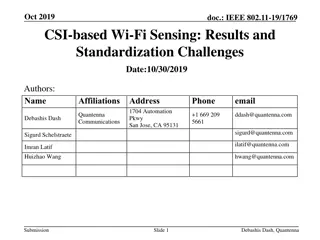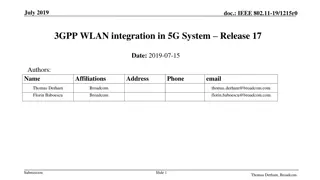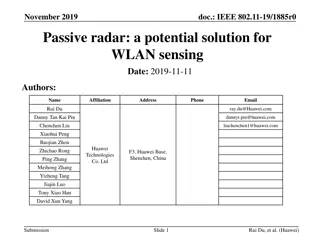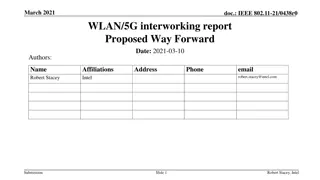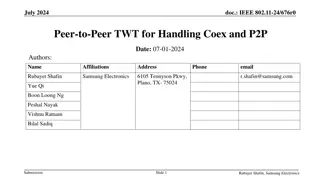IEEE 802.11-21/0391r0: Minimizing Impact in WLAN Sensing Design
The document presents discussions on minimizing impact as a design goal within the IEEE 802.11-21/0391r0 context, emphasizing the efficiency related to the impact of sensing on network performance. It addresses the current status, constraints, design options, and thoughts regarding WLAN sensing within the IEEE framework, stressing the importance of leveraging MAC/PHY features to achieve goals while minimizing system impact across use cases.
Download Presentation

Please find below an Image/Link to download the presentation.
The content on the website is provided AS IS for your information and personal use only. It may not be sold, licensed, or shared on other websites without obtaining consent from the author.If you encounter any issues during the download, it is possible that the publisher has removed the file from their server.
You are allowed to download the files provided on this website for personal or commercial use, subject to the condition that they are used lawfully. All files are the property of their respective owners.
The content on the website is provided AS IS for your information and personal use only. It may not be sold, licensed, or shared on other websites without obtaining consent from the author.
E N D
Presentation Transcript
March 2021 doc.: IEEE 802.11-21/0391r0 Minimizing Impact as a Design Goal Date: 2021-03-08 Authors: Name Chris Beg Affiliations Cognitive Systems Address 560 Westmount Road N. Waterloo ON, CA 560 Westmount Road N. Waterloo ON, CA Phone email chris.beg@cognitivesystems.com Mohammad Omer Cognitive Systems Submission Slide 1 Chris Beg, Cognitive Systems
March 2021 doc.: IEEE 802.11-21/0391r0 Abstract Begin discussion with TGbf to collect feedback on efficiency as it relates to impact of sensing on 802.11 data network performance Submission Slide 2 Chris Beg, Cognitive Systems
March 2021 doc.: IEEE 802.11-21/0391r0 Current Status Sensing is a technology intended to co-exist with a digital communication infrastructure Load percentages range from 1% to 10% as defined in Sensing Use-Cases document [2] Latest Functional Requirements document [1] does not state any preference on minimizing load introduced by sensing Submission Slide 3 Chris Beg, Cognitive Systems
March 2021 doc.: IEEE 802.11-21/0391r0 WLAN Sensing Constraints Sensing Use-Cases document [2] lists wide range of example applications, which vary in MAC/PHY constraints Sensing ultimately adds utility for the end-user, but communication will remain primary usage Sensing will occupy a percentage of available bandwidth, but can potentially impact data latency, throughput, available burst size. Sensing needs to ensure necessary resources are available for diverse list of use-cases, but also be aware of its impact on communication services and limit this impact to acceptable levels Submission Slide 4 Chris Beg, Cognitive Systems
March 2021 doc.: IEEE 802.11-21/0391r0 WLAN Sensing Design Options Sensing can leverage the many MAC/PHY features that 802.11 provides in order to achieve its goals E.g., Operating frequency, variable bandwidth, multiple antennas flexible topology, broadcasts transmissions, existing transmissions Contributions [3][4] outline a number of different sensing roles and scenarios which will help realize different use-cases It is important for TGbf to enable full use of the flexibility in the 802.11 MAC/PHY to minimize the system impact across the use-cases Submission Slide 5 Chris Beg, Cognitive Systems
March 2021 doc.: IEEE 802.11-21/0391r0 Thoughts Features introduced by TGbf should minimize the network impact, understanding fundamental WLAN use is digital communication Submission Slide 6 Chris Beg, Cognitive Systems
March 2021 doc.: IEEE 802.11-21/0391r0 References [1] 11-20-1813-00-00bf-ieee-802-11bf-functional-requirements-document [2] 11-20-1712-02-00bf-wifi-sensing-use-cases [3] 11-20-1850-00-00bf-overview-of-wi-fi-sensing-scenarios [4] 11-21-0147-00-00bf-definitions-and-scenarios-of-the-wlan-sensing-follow-ups Submission Slide 7 Chris Beg, Cognitive Systems
March 2021 doc.: IEEE 802.11-21/0391r0 SP1 Do you agree that the TGbf functional requirements document should include minimizing the impact of sensing functionality on the 802.11 data network performance as a design goal? Submission Slide 8 Chris Beg, Cognitive Systems
